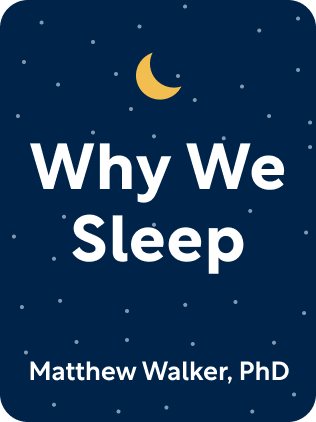

This article is an excerpt from the Shortform summary of "Why We Sleep" by Matthew Walker. Shortform has the world's best summaries of books you should be reading.
Like this article? Sign up for a free trial here .
What happens during REM sleep? How does REM sleep affect your brain?
Learning what happens during REM sleep can help you understand those crazy dreams, or learn to get a better night’s sleep overall. Keep reading to find out more about what happens during REM sleep.
What Happens During REM Sleep
REM and NREM are distinguishable by measuring electrical activity in the brain. NREM is characterized by slow (3-4 Hz) waves that propagate far from the frontal cortex to the back of the brain. REM is characterized by faster (30-40 Hz), frenetic activity that looks the same as being awake. But what happens during REM sleep?
Wakeful thought looks frenetic because many different neural signals are occurring at once throughout the brain. An analogy: it’s like a microphone picking up a football stadium full of distinct conversations. The summation of all the conversations just looks like noise.
In contrast to what occurs during REM sleep, NREM sleep is a slow, pulsing wave that’s noticeably different from REM sleep. Continuing the analogy, it’s like a stadium full of voices singing in synchronization. That billions of neurons can do this together is awe-inspiring.
What’s the function of these slow NREM waves? By being lower frequency, slow NREM waves can propagate further without attenuation, like AM radio waves. The author suggests this is useful in transferring memories far across the brain, from temporary memory stores toward more permanent storage. It also allows communication across the brain for different sections to collaborate on their shared experience.
REM sleep looks like awake activity, and it’s where dreams happen. Here’s a glimpse of what happens during REM sleep:
- Your sense of time in dreams seems dilated – an hour may seem to pass when in reality only 5 minutes have.
- Unlike the rest of sleep, you consciously perceive your senses, like sight and sound. In non-REM sleep, the thalamus in your brain blocks you from consciously perceiving senses. Once REM sleep starts, this blockade is released.
- In REM sleep, your eyes move rapidly This was initially thought to be visual exploration of the dream field, but this turns out to be more related to the creation of REM sleep than passive observation of it.
If REM sleep looks like wakefulness, how can an observer distinguish someone who’s dreaming from being awake? Muscle atonia – during REM sleep, your voluntary muscles are completely limp. Your brain does this to prevent you from acting out your dreams, since fighting an enemy might cause you to accidentally punch your surroundings.
One last detail: sleep spindles (bursts of activity) are part of what happens during REM sleep. Sleep spindles occur at the end of slow waves, possibly serving a function to block external sensory input from disrupting sleep. People with more sleep spindles are heavier sleepers.
REM Sleep Blunts Emotional Pain from Memories
What happens during REM sleep that helps you stay emotionally present? REM dreaming reduces pain from difficult emotional experiences. The brain seems to reprocess upsetting memories and emotional themes, retaining the useful lessons while blunting the visceral emotional pain. This might be why we can look back at painful memories without feeling the original full emotional intensity.
Interestingly, dreaming about the upsetting content itself, or its emotional themes, is necessary to have this emotional blunting effect. REM sleep by itself does not.
How might this happen? In REM sleep, the stress hormone norepinephrine in your brain is reduced to zero, which possibly allows the brain to process upsetting memories in a “safe” brain environment. In fact, REM sleep is the only time that norepinephrine is absent from your brain.
Suggestive evidence:
- PTSD patients have elevated norepinephrine in REM sleep. They also have recurring nightmares where the pain of the memory does not fade, either dreaming or wake.
- Reducing norepinephrine levels through a drug reduces PTSD severity in a subset of patients.
- In an experiment, subjects were shown a series of emotionally triggering images two separate times, separated by ~12 hours. One group saw set 1 before sleeping and set 2 after sleeping. The other group saw both in the same day without sleeping, set 1 in morning and set 2 at night. The former group reported much less emotional disturbance upon seeing the images the second time, suggesting sleep had blunted their emotional reaction.
REM Sleep Increases Understanding of Other People’s Emotions
Sleep deprivation reduces your ability to interpret subtle facial expressions. Sleep-deprived people more often interpret faces as hostile and aggressive.
Suggestive evidence: people on the autism spectrum have disrupted REM sleep. They also have issues reading people’s facial expressions
This function seems to begin in adolescence, when kids have to start navigating the social world independently.
Imagine the mistakes sleep-deprived professionals can make – police, medical staff, parents – if they mistake faces for aggression.
REM Sleep Increases Creativity
REM sleep creates novel associations between ideas, increasing creativity and problem-solving.
Another interesting thing that is part of what occurs during REM sleep is that our brains make creative connections. Informally, imagine the brain asking: “how can I connect what I’ve recently learned with what I already know, thus discovering insightful revelations? What have I done in the past that might be useful in solving this new problem?”
Thomas Edison knew the power of dreams. Reportedly, he would fall asleep holding metal ball bearings, releasing them just as he entered REM sleep. The noise would wake him up, just in time for him to write down his dreams before he forgot them.
These experiments showed a bevy of positive effects on creativity:
- REM sleep creates novel connections, between distantly related concepts
- In essence, the brain takes and builds a larger mental network of separate ideas. For example, you learn A->B and B->C separately, and the brain forms the larger relationships A->B->C.
- In this way, your brain connects new experiences to old ones. If you have to solve a problem today, you might think back to a similar problem you solved on vacation 5 years ago.
- REM sleep creates higher-level comprehension of ideas, finding the patterns among the noise
- Examples: language learning as a child, finding shortcuts for solving repetitive math problems
- REM sleep increases the ability to solve creative problems
- In an experiment, subjects in sleep were woken up to solve anagrams (eg OEOSG = GOOSE). Those waking up from REM sleep solved 15-35% more puzzles than those in NREM sleep or while awake.
- The content of REM sleep matters when solving that problem
- In an experiment, subjects were given a maze to solve and given a chance to nap. People who dreamt about issues related to mazes were 10x better at solving the maze upon waking, vs people who didn’t dream about mazes.
- The book cites Mendeleev, the chemist who developed the breakthrough periodic table of elements. He reported happening upon the solution in a dream
(Experimentally, how do we know that what occurs during REM sleep specifically helps with creativity? First, scientists define an exercise that has to do with creativity, like puzzle solving. Next, they split subjects into a sleep group and a non-sleep group. They measure each subject’s REM sleep with electrodes, and they show that more REM sleep increases performance on that exercise.)
There’s a lot that goes into what happens during REM sleep. Understanding what happens during REM sleep can help you get better sleep each night and plan for your sleep cycle.

———End of Preview———
Like what you just read? Read the rest of the world's best summary of Matthew Walker's "Why We Sleep" at Shortform .
Here's what you'll find in our full Why We Sleep summary :
- Why you need way more sleep than you're currently getting
- How your brain rejuvenates itself during sleep, and why nothing can substitute for sleep
- The 11-item checklist to get more restful sleep today






